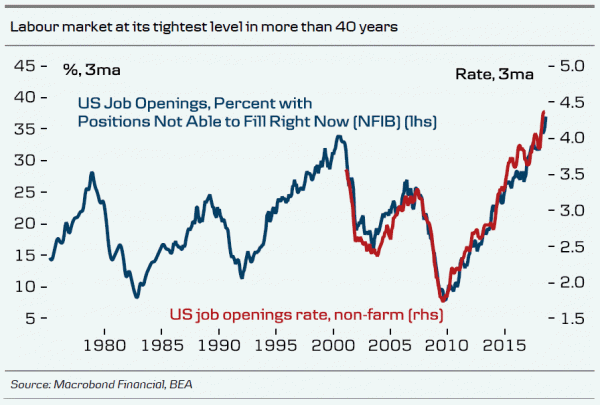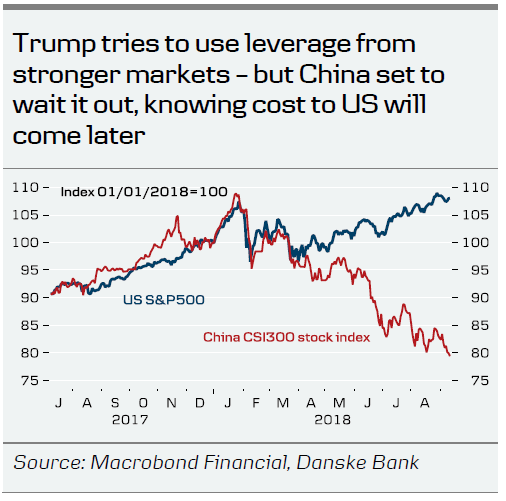Key points
- Tight US labour market a rising risk to growth.
- US-China trade war set to escalate further before deal is reached.
- Emerging market assets cheaper but still short-term risks.
Tight labour market a rising challenge to US growth
The main news in the US labour market report last week was a 2.9% jump in wage growth. It was the highest level in close to 10 years and suggests a tight labour market is starting to feed into higher wage growth and thus inflation pressure – something that has been missing so far. However, Thursday’s inflation data painted a different picture. US core inflation surprised on the downside, rising only 2.2% y/y in August, down from 2.4% y/y in July. Hence, the jury is still out on whether we are finally getting higher inflation in the US.
However, indicators of tightness in the labour market suggest that US companies are finding it increasingly difficult to find skilled labour (see chart below) – something that typically translates into higher wage growth and inflation eventually.
Even if inflation fails to pick up, it could still prove an obstacle for growth. For companies to keep increasing production, they need more hands. If they face bottlenecks, it could put a brake on growth. Similarly, it would be likely to pave the way for continued higher policy rates by the Fed to stem demand growth and lean against the wind to avoid overheating.
A way to keep strong growth even with bottlenecks in the labour market is by squeezing more out of each worker – in other words, by increasing productivity growth. However, so far there is no sign of rising productivity growth, which is still hovering around 1% y/y, much lower than the 3% level prior to the financial crisis. While US President Donald Trump is stating his policy is already working by boosting growth, there is no evidence that it is raising the potential growth rate of the US economy.
Rather, the tax cuts are boosting demand and thus pushing up production faster. However, unless productivity growth increases, the higher demand growth will just use up the available resources earlier than otherwise. It will also push up investment orders to increase production capacity but without available labour, it is hard to produce more investment goods as well. For now, we continue to look for 2.7% growth this year and 2.5% in 2019. However, we need to see higher productivity growth soon for this to be within reach.
The tighter labour market underpins our expectation of another two rate hikes this year, followed by another three hikes next year. We look for the Fed to be on autopilot until March, when we expect rates to hit the neutral rate of 2.75-3.00%. After this, it is likely to be more cautious.
In the euro area, wage pressures have also picked up lately. Wage growth currently stands at 2.3%, after hitting a bottom two years ago at 1.0%. At the ECB meeting this week, the ECB seemed increasingly confident that wage growth would move higher and push up inflation as well over the medium term.
US-China trade war: further escalation coming
In the US-China trade war, we are still waiting for Trump to reveal when he will go through with a 25% tariff on another USD200bn of Chinese imports. Developments this week suggest it is only a matter of time. Trump was quick to quash a small hope that the US and China would meet for high-level trade talks. While China confirmed it had received an invitation for trade talks from Treasury Secretary Steven Mnuchin, Trump tweeted shortly after that the US was under no pressure to meet with China and that ‘our markets are surging, theirs are collapsing’. With this signal, it is very unlikely that China will enter into new high-level talks. Having already been burnt once in May when Trump left negotiations, China is unlikely to go into new talks without a clear signal from Trump that he is serious about reaching a deal. China strongly opposes US bullying and what it calls Trump’s ‘winner-takes-all’ approach to deal making. In China, deals have to have a ‘win-win’ outcome. No Chinese leader can afford to look like it is giving in to US bullying. Hence, we continue to expect the tariffs on USD200bn worth of Chinese goods to come into effect within the next month and we expect China to retaliate.
Emerging markets: looking cheaper but still short-term risks
Emerging market assets have been through a rough time lately, taking a hit from a slowdown in China, higher US policy rates and crises in several emerging market economies such as Turkey, Argentina and, to some extent, South Africa. While many emerging market assets are getting cheaper, we still see short-term risks from a further escalation in the US-China trade war and further US Fed hikes. However, from a long-term point of view, many emerging market assets look increasingly attractive.



















